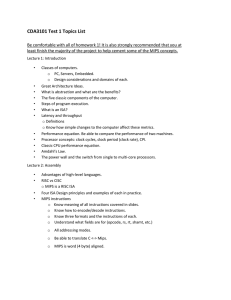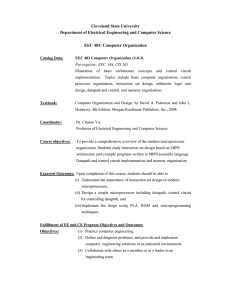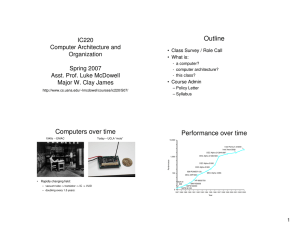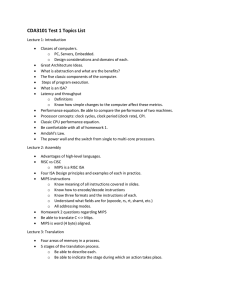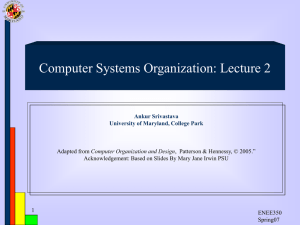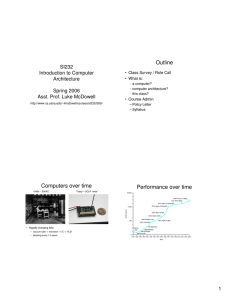Lecture Set 1
advertisement
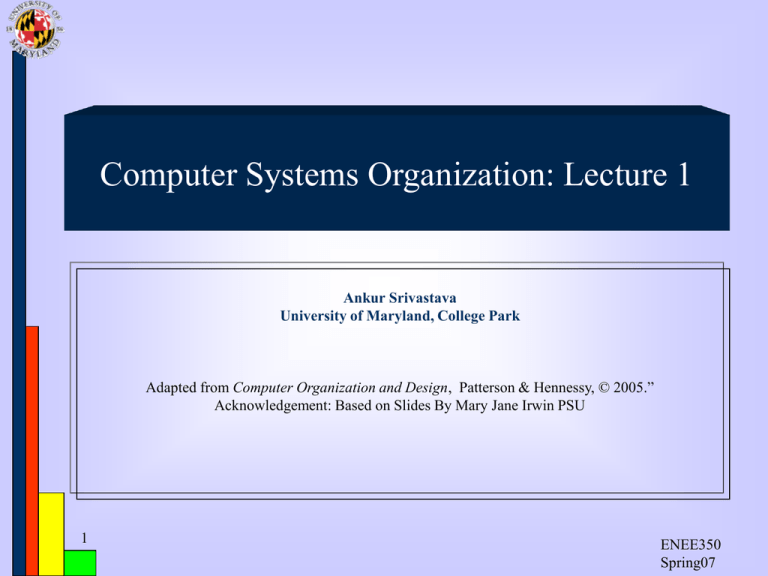
Computer Systems Organization: Lecture 1 Ankur Srivastava University of Maryland, College Park Adapted from Computer Organization and Design, Patterson & Hennessy, © 2005.” Acknowledgement: Based on Slides By Mary Jane Irwin PSU 1 ENEE350 Spring07 Where is the Market? Millions of Computers 1200 1122 1000 892 Embedded Desktop Servers 862 800 600 488 400 290 200 0 93 3 1998 2 114 3 1999 135 4 2000 129 4 2001 131 5 2002 ENEE350 Spring07 Performance (SPEC Int) Processor Performance Increase 10000 DEC Alpha DEC Alpha 21264A/667 21264/600 1000 100 10 SUN-4/260 1 1987 Intel Pentium 4/3000 Intel Xeon/2000 DEC Alpha DEC Alpha DEC Alpha 5/500 4/266 DEC 5/300 IBM POWER AXP/500 100 HP IBM 9000/750 MIPS RS6000 MIPS M2000 M/120 1991 1989 1993 1995 1997 1999 2001 2003 Year 3 ENEE350 Spring07 DRAM Capacity Growth 1000000 Kbit capacity 100000 16 4M M 10000 512 256 M 128 M 64 M M 1M 1000 256 K 64K 100 16K 10 1976 1978 1980 1982 1984 1986 1988 1990 1992 1994 1996 1998 2000 2002 Year of introduction 4 ENEE350 Spring07 Example Machine Organization Computer CPU 6 Memory Devices Control Input Datapath Output ENEE350 Spring07 Giving instructions to a Computer • We ordinarily program in a high level language like C, Java, would like to use human speech etc. • Computers being digital machines understand the language of 0 and 1. • How do we translate from a high level language to machine language • How do computers take these instructions given in machine language and execute them. 7 ENEE350 Spring07 Giving instructions to a Computer High level Language Compiler Assembly Code Assembler Machine Code 8 ENEE350 Spring07 Giving instructions to a Computer Computer understand the language of 0 and 1 but we as programmers cannot code in them Around 70S, assemblers were invented to translate so called assemply code into machine code. Assembly level code was a human readable instruction sequence for the computer. We will be disucssing the MIPS assembly code 9 ENEE350 Spring07 (vonNeumann) Processor Organization • Control needs to CPU Memory Devices 1. input instructions from Control Input Memory 2. issue signals to control the Datapath Output information flow between the Datapath components and to Fetch control what operations they perform Exec Decode 3. control instruction sequencing • Datapath needs to have the – components – the functional units and storage (e.g., register file) needed to execute instructions – interconnects - components connected so that the instructions can be accomplished and so that data can be loaded from and 10 stored to Memory ENEE350 Spring07 Basic Datapath Organization Registers ALU Memory Registers are a bank of flip flops. Are expensive to have in large numbers, therefore need to be augmented by memory (DRAMS, SRAMS, DISKS) 11 ENEE350 Spring07 MIPS R3000 Instruction Set Architecture (ISA) • Instruction Categories – Computational – Load/Store – Jump and Branch – Floating Point • coprocessor – Memory Management – Special R0 - R31 PC HI LO Registers 3 Instruction Formats: all 32 bits wide OP rs rt OP rs rt OP 12 rd sa immediate jump target funct R format I format J format ENEE350 Spring07 Example of MIPS Instruction Add $t0, $s1, $s2 Sub $t0, $s1, $s2 destination source1 op source2 The operands and the final destination are MIPS Registers 13 ENEE350 Spring07
